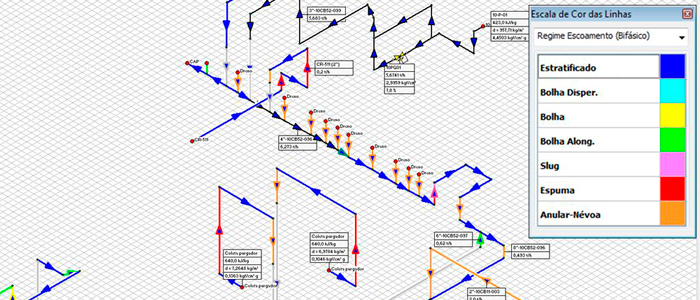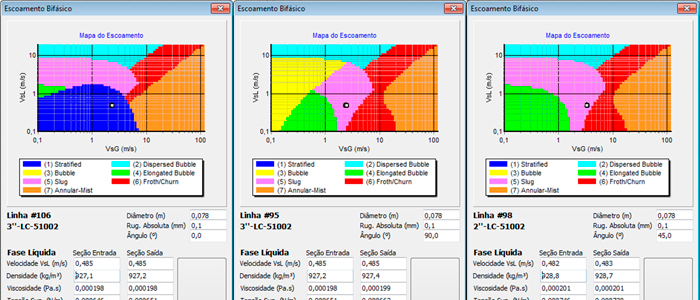Figener has extensive experience in flow analysis for several flow conditions (fluid mechanics), which was obtained through several studies carried out in large industrial complexes, such as Braskem and Alunorte, participating in several studies / analyzes of new Green Field and participating in expansion projects.
Its advantage lies on a highly qualified technical team capable of performing from in-line measurements to complex calculations, aided by self-developed calculation tools (FNESS, software widely recognized among engineers). Therefore, coupled with the experience of several studies undertaken, FIGENER is capable of making highly accurate diagnosis on solving fluid flow problems.
FIGENER is capable of performing the following activities:
- In-Line measurements (flowrate, pressure and temperature).
- Flow Distribution Studies in Complex Networks (Cooling Systems).
- Simulation of operating modes.
- Head loss calculation for flows in pipes and closed conduits (including two-phase and gaseous flows)
- Evaluation of FAC (Flow-accelerated Corrosion) in Boiler Feedwater lines.
- Hydraulic Transients Studies.
- Steam Transients analysis for thermoelectric studies.
- Computer aided flow analysis (internal / external) with CFD (Computational Fluid Dynamics) method.
Flow analysis is usually necessary when there is evidence of process limitations due to wrong pipeline dimensioning. These studies are also performed for plant expansions and plant revamps, which normally have utilities such as cooling systems and cool water generation, where the intention is to take advantage of the existing equipment and lines. Once the system is modeled properly, it is possible to perform the flow analysis for different operating modes (partial load, full capacity), thus obtaining a more adequate diagnosis.
Furthermore, on several occasions, FIGENER carried out energy efficiency studies, optimizing the dimensioning of lines. Some of the benefits of proper sizing are:
- Energy Efficiency.
- Reduction in investments.
- Better flow Distribution in pipelines, eliminating possible bottlenecks.
- Reduction of accidents due to line breakage, caused by transients or FAC.
Main references:
- Cooling Circuits of several Braskems units.
- Boiler Feedwater Circuits.
- Steam System at Braskem and Alunorte units.
- Steam condensate return circuits to Braskem units.
- ENEVA Termoparaíba water intake System.
- Mondelez chill water circuits and Light (Power Company) Projects.
- Fire protection system of Braskem units.
The studies are detailed below.
COMPLEX NETWORK ANALYSIS
Since the 90s, FIGENER has contributed to the Brazilian industry with flow distribution analysis in complex network, initially for cooling water networks. It was then that the development of the FNESS software, capable of simulating these incompressible fluid circuits, began. Over the years, these analyzes have been improved, starting to perform calculations for networks of steam and compressible fluids. FIGENER’s Flow analysis includes
- Validation of pump and blowers dimensioning.
- Cooling towers dimensioning.
- Block valves and control valves dimensioning.
- Thermal Balances (Thermal Cycles, Heat Exchangers).
HYDRAULIC TRANSIENTS
FIGENER also has experienced engineers and licenses of well-known software for analyzing hydraulic transients in networks. Hydraulic transients are analyzed from scenarios generated in a controlled manner, by the software operator, or in an undesirable manner, as a result of an external event such as:
- Pump trip due to power failure and emergency valve shutdown;
- Inadequate selection of pumping system components (eg: improper closing of check valves);
- Maintenance carried out carelessly.
This type of analysis has the objective of mitigating high pressure variations that can cause damages to the installations, usually resulting in the rupture / breakage of pipes and equipment
When they occur in an uncontrolled manner, hydraulic transients can configure unacceptable flow conditions and cause damage to the hydraulic systems. Among the main problems, it can be highlighted
- Overpressure in the system which can cause permanent deformation or rupture of pipes and components;
- Underpressure in the system, which may cause collapse of pipes or foreign fluids to the system entering the pipeline through joints or connections;
- Reverse flow causing damage to pumps, check valves and / or emptying of tanks and reservoirs;
- Excessive piping vibration that can cause mechanical failures to pipelines subjected to excessive vibration or even to adjacent lines;
- Low flow speed in effluent disposal lines, which can cause clogging.
The analysis of the variation of these quantities, in turn, allows the identification of possible problems generated from the simulated events, as:
- Liquid column separation and the consequent formation of steam pockets (cavitation).
- Sudden variations in the flow speed.
- Collapse of steam pockets and hydraulic hammers (water hammer).
The simulation can be performed for a series of equipment (liquid accumulators, gas accumulators, surge tanks, pressure control valves, flow control valves, check valves, safety valves, vacuum breakers, pumps, in addition to other equipment) which allows the modeling of complex systems.
After diagnosing the problems, alternatives are proposed to mitigate or even eliminate the harmful effects due to unwanted hydraulic transients. Some of the alternatives are: the inclusion of quick-closing check valves, installation of flywheels, installation of surge tanks, installation of hydro pneumatic tanks, controlled start (soft start), installation of vacuum breakers and other applicable alternatives, always aiming for the best option for each hydraulic system
Some customers who have already carried out hydraulic transient studies with FIGENER are: BRASKEM, SABESP, ENEVA, THYSSENKRUPP, GALVANI, PROMON.
TWO PHASE FLOW
Many industries have problems with their condensate systems, usually due to the poor dimensioning of their lines, which can cause serious accidents with unexpected line breaks. Typically, accidents are pipe breaks resulting from erosion wear or even FAC, associated with excess speed of the two-phase flow that occurs on these lines.
The hydraulic calculation performed by FNESS is based on the application of Bernoulli equation in system nodes, junction / interchange points, as well as in points that characterize changes in the elevation of pipelines. The results of the calculation can be shown, directly, on the problem representation diagram, indicating pressures and temperatures of nodes, flows in interconnection elements and flow direction
In 2011, FNESS began to be modified to allow variations in density, as well as the inclusion of mixture of flows with different densities in the principle of energy conservation, an essential condition for treating biphasic flow. In addition to this adaptation, the particular head loss models of each two-phase flow regime were included, and the models presented by Nicholas Petalas and Khalid Aziz in A Mechanistic Model for Stabilized Multiphase Flow in Pipes were adopted.
As a result, the following regimes can be identified:
- Stratified Smooth flow.
- Stratified Wavy flow.
- Elongated bubble flow.
- Slug flow
- Froth or chum flow
- Annular-Mist flow.
- Dispersed bubble flow.
In addition to the modification in calculation methods, new graphic resources were included in FNESS for evaluating condensate systems, such as:
Color scale applied to the network diagram, allowing to visualize:
- Flow regime.
- Average flow velocities and erosional velocity (API) ranges.
- Pressure, temperature and steam fraction intervals.
- Construction of the two-phase Flow Map.
The images below show some results of the modifications in the software:


From the simulations, it is possible to search for alternatives in order to minimize the diagnosed problems.
STEAM TRANSITORY
Complex steam systems operations, where turbo-generators (electricity generation), steam generators and consumers are present at various pressure levels, are subject to various disturbances and / or accidents. These disturbances can spread in a damaging way, causing more dangerous accidents than the original, even causing the complete stoppage of the plant.
Among the most common accidents, the following may be highlighted:
- Turbogenerator trip.
- Boiler/Steam generator trip.
- Loss of synchronization with the public network.
- Electric blackout.
- Total stoppage of utilities.
For the analysis of these systems, FIGENER has developed TRANSVAP, a very powerful software that analyzes the evolution of pressures, temperatures, flows and any thermodynamic quantity, over the seconds following an accident. With the aid of the software, it is possible to investigate various occurrences, in addition to simulating several alternatives for correcting steam systems, presenting recommendations for solving the problems arising from sudden variations in consumption.
As an example, it can be shown that the installation of reducing valves in parallel with a back pressure turbine is sufficient to maintain the minimum pressure value in the low pressure line manifold, and at the same time avoid opening the safety valve of boiler drums.
Steam system modeling allows evaluating the variation of the electric generation in turbo-generators, with the control functions associated with the machine speed and pressure of the discharge manifolds. For this purpose, all gearboxes, safety valves, desuperheaters, etc. are included in the software. The software also allows obtaining temporal variation of metal temperature for pipes within a boiler.
The implemented model has been applied by FIGENER in several works since 1991. Some clients who have already carried out studies of steam transients are: COPENE (Braskem), COPESUL (Braskem), CSN, Klabin, Níquel Tocantins, Alunorte, UTE Cubatão.
The simulation of events such as boiler trip, turbine trip, or even wide variations in consumption (in case of departure of a large consumer), provides the analyst with conditions to verify whether the resulting disturbance is dangerous and whether it can be absorbed by the system without triggering shutdowns or general collapse.
Thus, one of the envisaged applications is the transformation of TRANSVAP into a training instrument for the operation of thermoelectric plants and petrochemical units, due to the high programming flexibility that their calculation cores allow.
A petrochemical system, formed by pyrolysis furnaces, compressors and piping, for example, can be modeled and integrated into the steam system, enabling the designer and operators to predict the system´s behavior in the face of a turbine trip, loss of oven, or any other occurrence.
CFD ANALYSIS (COMPUTER FLUID DYNAMICS)
Whether internal or external flow, Figener is able to perform analyzes using CFD tool.
Learn more @ here .
